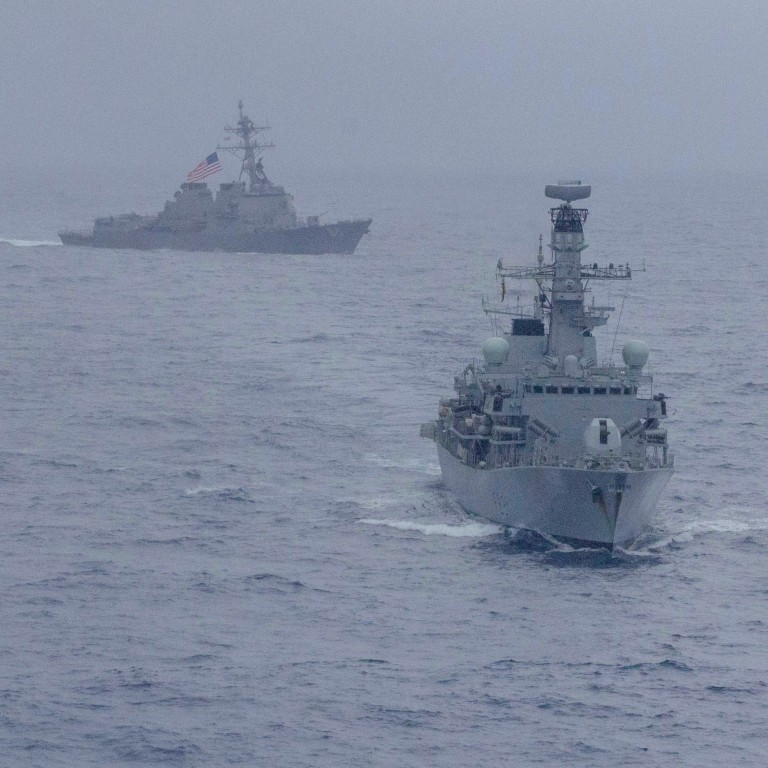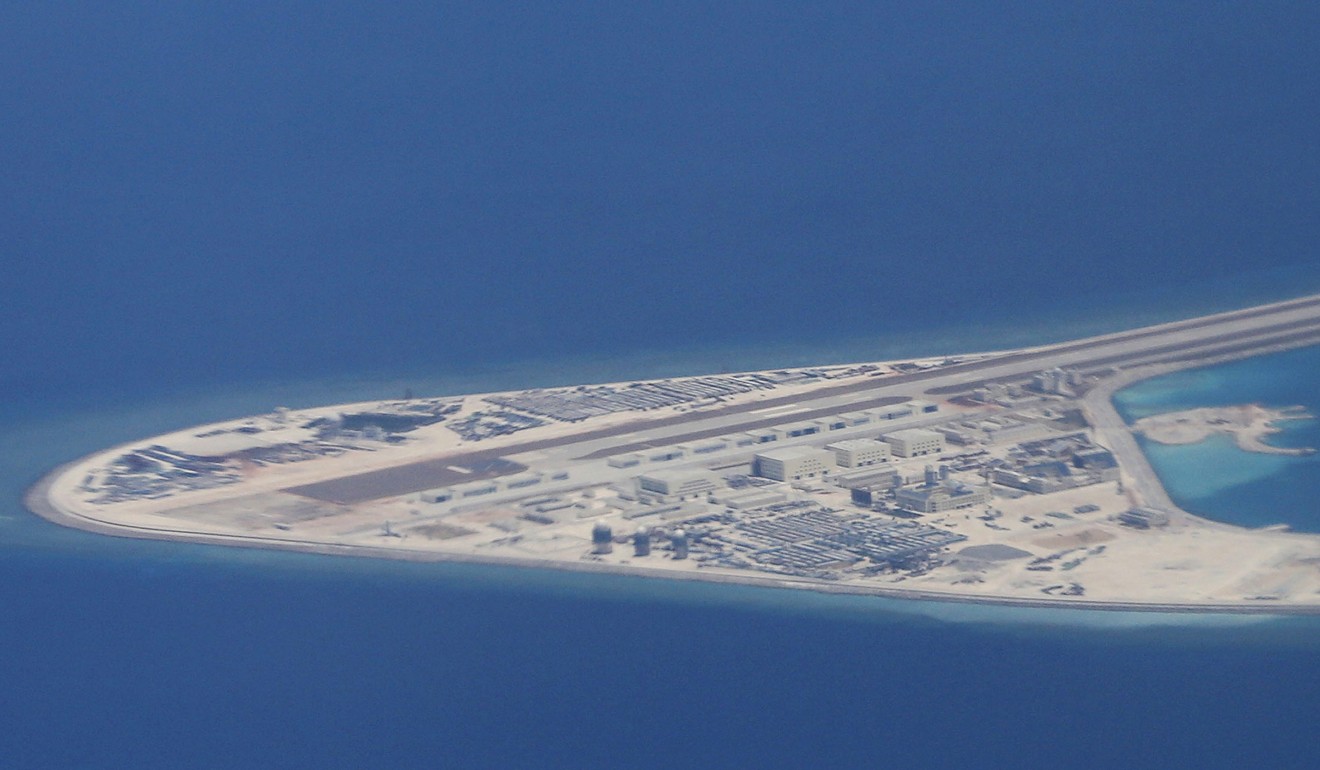
On course for a moment of truth in South China Sea as US Navy ups the ante
- The Pentagon is stepping up its freedom of navigation operations and openly challenging Chinese paramilitary forces in the disputed region, but it seems to have only emboldened China to fortify its claims
The South China Sea disputes are fast approaching a moment of truth as Washington embraces a full-spectrum strategy to challenge China’s expanding footprint in the area.
In particular, the US Navy is stepping up its freedom of navigation operations (FONOPs) and now openly challenging China’s so-called grey zone activities in the disputed region.
If left unchecked, the intensified game of chicken between the two superpowers could very well ignite the next global conflict. So far, the FONOPs have been provocative enough to encourage further Chinese assertiveness, but not robust enough to check the Asian powerhouse’s expanding military footprint in the area.
Submarine arms race seen heating up in Indo-Pacific amid ‘great threat’ from China
As Barbara Tuchman demonstrated in The Guns of August (1962), great powers can easily sleepwalk into cataclysmic wars, since “in the midst of … crisis nothing is as clear or as certain as it appears in hindsight”.
The first world war, she warned, was after all the tragic upshot of personal miscalculations and shared misperceptions reaching a destructive apotheosis.
Tuchman highlighted the “disposition of everyone on all sides not to prepare for the harder alternative, [and] not to act upon what they suspected to be true” but instead embrace the convenient delusion that the opposing side will succumb short of armed conflict.

Since 2013, China has engaged in an unprecedented campaign of altering both the geopolitical as well as geological configuration of the South China Sea disputes.
Through state-of-the-art reclamation, China has fortified its de facto control over numerous land features in the Paracel and Spratly island chain.
A number of them, namely the Fiery Cross, Mischief and Subi reefs, have been turned into full-fledged islands, which now host world-class airstrips, large military facilities, and advanced weapons systems.
Rivals and neighbouring countries, particularly Vietnam, have openly accused China of militarising the disputes and laying the foundation for an air defence identification zone in an international waterway.
Beijing insists on ‘indisputable sovereignty’ over South China Sea islands as US warships test troubled waters
American leaders such as US Senator James Inhofe, the chairman of the powerful Senate Armed Services Committee, have effectively accused China of “preparing for World War III” by militarising a vital global maritime artery.
In an act of policy acrobatics, Washington maintains official “neutrality” on the sovereignty status of the disputed islands, but has openly challenged Beijing’s claims by deploying warships within the territorial sea of Chinese-occupied land features.
The US has tried to square the circle by arguing that China, more than any other claimant state, represents a direct threat to freedom of military navigation and overflight in the area. China is the only major power to openly oppose American naval activities within its 200-nautical-mile exclusive economic zone.
The administration of Donald Trump has upped the ante by regularising increasingly aggressive FONOPs and openly challenging Chinese paramilitary forces in the area. Most recently, it deployed two guided-missile destroyers, the USS Spruance and USS Preble, to the Spratly Islands.
When Barack Obama was president there was barely a single FONOP carried out every quarter, but the current administration has conducted one almost every month.
US commander pushes for more funding to counter China’s influence in Indo-Pacific
Last November, former defence secretary James Mattis went so far as calling on China to remove military assets on disputed land features, while openly confronting China’s use of paramilitary forces in disputed waters.
During the US-China Diplomatic and Security Dialogue in November, the former defence chief called on all Chinese “military, law enforcement and civilian vessels and aircraft … to operate in a safe and professional manner in accordance with international law as we seek peaceful resolution of all disputes in the South China Sea”.
In effect, the Pentagon has warned China that it will treat the People’s Armed Forces Maritime Militia (PAFMM) and other paramilitary Chinese forces as standard naval forces. So the US Navy will apply the same rules of engagement to the Chinese Navy and the PAFMM.
This month, Admiral John Richardson, chief of US naval operations, once again focused on “grey zone” or “short of conflict encounters” in the South China Sea.
Under the “war without gun smoke” strategy, the Pentagon maintains, China has used a combination of “white hull” paramilitary and coastguard forces, along with the “grey hull” Chinese navy, to enforce expansive territorial claims, intimidate rivals in the contested area, and restrict freedom of military navigation for external powers.
The American admiral warned Beijing against “obstructing one another, driving our ships in front of one another, throwing obstacles in front of the ship”, and called for a “more muscular” American approach to countering China’s use of paramilitary and other “grey zone” tactics.
Irked by a “meddlesome” America, China has repeatedly issued “stern complaints” to Washington, arguing that it maintains “inherent and indisputable” sovereignty over a whole host of disputed land features in the South China Sea.
Far from dissuading China, the Pentagon’s expanding naval footprint seems to have only emboldened China to fortify its claims in the area. As Yue Gang, a former People’s Liberation Army colonel, points out, China is unlikely to recalibrate its strategy, since “grey zone tactics still enjoy a geographical advantage against the US”, and China’s “significantly expanding” paramilitary forces “could hardly be challenged by other neighbours in the region”.
The upshot is a strategic deadlock, which underscores the importance of institutionalising conflict-prevention mechanisms. At the very least, the two superpowers could more assiduously implement confidence-building measures such as the 2014 Code for Unplanned Encounters at Sea, which was designed to avoid unintended clashes. Perhaps it is also high time for both sides to extend such mechanisms to their respective white hull forces, including the Chinese paramilitary elements.
Richard Heydarian is a Manila-based academic and author

